SaraPIC
Download as docx, pdf0 likes569 views
The document contains 10 programming problems related to basic C concepts like data types, operators, functions, arrays, pointers etc. Each problem has the code to solve it along with sample input/output. The problems cover topics like number formatting, arithmetic operations using switch case, finding min/max, addition of numbers, matrix operations, string functions and recursion.
1 of 18
Download to read offline
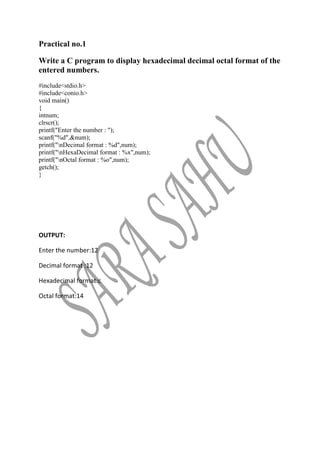


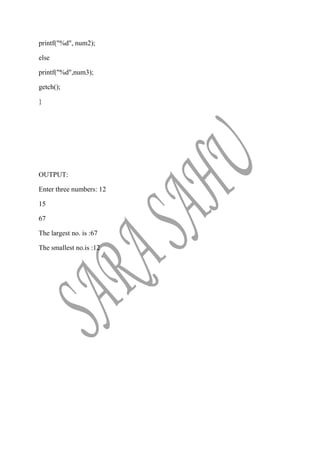
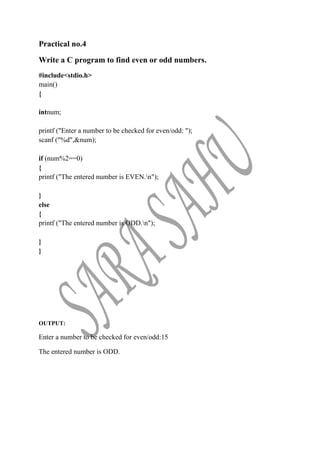

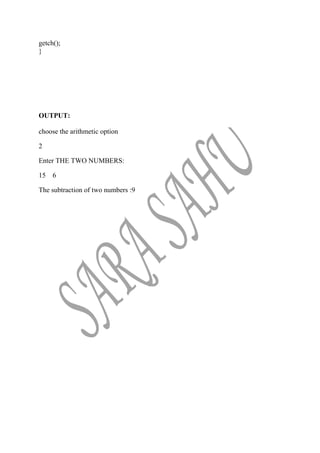
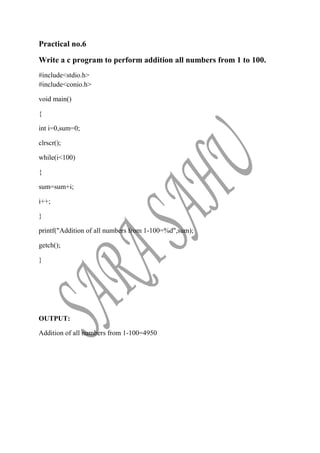
![Practical no.7
Write a C program to find smallest and largest number from array
elements.
#include<stdio.h>
#include<conio.h>
Void main()
{
int a[20],min,max;
intn,i;
clrscr();
printf("enter the num of elementst:");
scanf("%d",&n);
printf("enter the elementsn");
for( i=0;i<n;i++)
{
scanf("%d",&a[i]);
if(i==0)
{
min=max=a[i];
}
if(a[i]<min)
min=a[i];
else if(a[i]>max)](https://image.slidesharecdn.com/sarapic-121002111253-phpapp01/85/SaraPIC-9-320.jpg)
![max=a[i];
}
printf("largest element is %d n Smallest element is %d ",max,min);
getch();
}
OUTPUT:
enter the num of elements:5
enter the element:12
56
23
10
78
largest element is 78
Smallest element is 10](https://image.slidesharecdn.com/sarapic-121002111253-phpapp01/85/SaraPIC-10-320.jpg)
![Practical no.8
Write a C program to enter elements for 3*3matrix and display them.
#include<stdio.h>
#include<conio.h>
void main()
{
int a[3][3],i,j;
clrscr();
printf("ENTER ELEMENTSn");
for(i=0;i<3;i++)
{
for(j=0;j<3;j++)
{
scanf("%d",&a[i][j]);
}
}
printf("THE ELEMENTS IN 3*3 MATRIX FORM ISn");
for(i=0;i<3;i++)
{
for(j=0;j<3;j++)
{
printf("%d",a[i][j]);
}
printf("n");
}
getch();
}
OUTPUT:
ENTER ELEMENTS
1
2
3
4
5
6
7
8
9
THE ELEMENTS IN 3*3 MATRIX FORM IS
1 2 3
4 5 6
7 8 9](https://image.slidesharecdn.com/sarapic-121002111253-phpapp01/85/SaraPIC-11-320.jpg)
![Practical no.9
Write a C program to demonstrate output of standard library
functions. Strlent( ),strcpy( ),strcat( ),strcmp( ).
#include<stdio.h>
#include<conio.h>
#include<string.h>
void main()
{
char s1[10],s2[10],s3[30];
int a;
clrscr();
printf("enter the two stringsn");
scanf("%s%s",&s1,&s2);
printf("1st String=%sn2ndString=%s",s1,s2);
if(strcmpi(s1,s2) == 0 )
printf("Entered strings are equal.n");
else
printf("Entered strings are not equal.n");
a=strlen(s1);
printf("nLength=%d",a);
strcat(s1,s2);
printf("nconcatinated string=%s",s1);
strcpy(s1,s2);
printf("ncopied string=%s",s1);
getch();
}](https://image.slidesharecdn.com/sarapic-121002111253-phpapp01/85/SaraPIC-12-320.jpg)
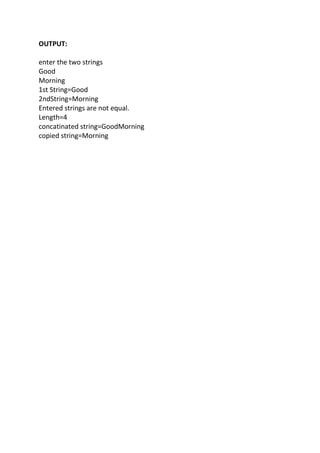
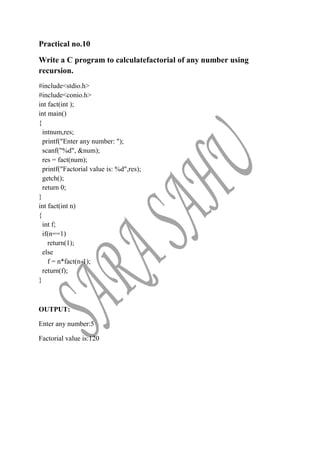
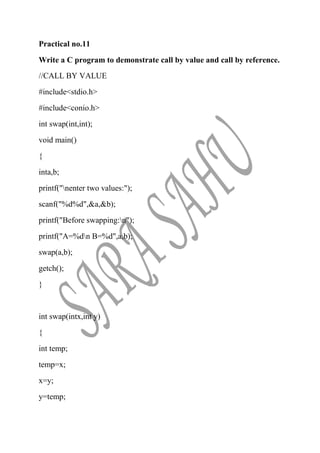

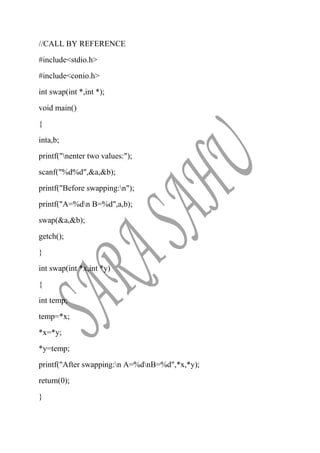
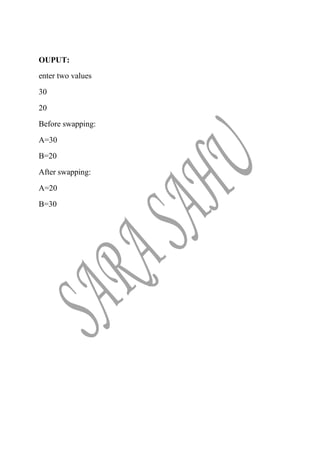
Ad
Recommended
Data Structure using C
Data Structure using CBilal Mirza
╠²
The document outlines multiple programming examples that demonstrate various algorithms using C language, including finding the sum of natural numbers, generating Fibonacci series, computing factorials, and performing basic array operations like insertion, deletion, and merging. Each program is accompanied by source code, error notes, and execution results showing successful code execution without errors. Additionally, advanced data structures such as stacks, linear queues, and circular queues are also implemented.Basic c programs updated on 31.8.2020
Basic c programs updated on 31.8.2020vrgokila
╠²
The document provides examples of basic C programs that demonstrate fundamental programming concepts like printing values, arithmetic operations, arrays, functions, conditionals, loops, and matrices. The programs cover topics such as printing and reading integers, adding/multiplying numbers, swapping values, checking vowels/consonants, Armstrong numbers, palindromes, summing matrices, and finding the transpose of a matrix.C lab manaual
C lab manaualmanoj11manu
╠²
The document contains C code snippets for various programming problems including calculating the area of shapes, finding roots of quadratic equations, sorting arrays, matrix multiplication, and more. The last problem is a program to list the names of students who scored over 60% total marks across three subjects, using a structure variable to store student data.C Programming Example
C Programming ExamplePRATHAMESH DESHPANDE
╠²
The document contains a series of programming exercises in C, each with code snippets and expected outputs. It includes programs for generating patterns, finding maximum values, calculating GCD, transposing matrices, deleting array elements, performing matrix operations, and other tasks. Each exercise consists of a question prompt, the relevant C code, and the expected output.C Programming Example
C Programming Example University of Potsdam
╠²
This C program allows a user to answer multiple choice questions (MCQs) and checks their answers. It prints out 5 questions, each with 3 possible answers, and prompts the user to enter the number of the correct answer. It then checks each submitted answer and prints whether it is true or false. This allows the program to automatically grade a short quiz consisting of basic MCQs.Practical File of C Language
Practical File of C LanguageRAJWANT KAUR
╠²
The document contains 34 code snippets showing C programming examples using arrays, loops, functions, conditional statements, and other basic programming concepts. The code snippets demonstrate how to:
1) Print messages, take user input, perform basic math operations like addition and averaging numbers
2) Check conditions like even/odd, positive/negative, leap year
3) Use different loops like while, for, do-while to iterate
4) Define and call functions to modularize code for swapping, factorial, Fibonacci series etc.
5) Use one-dimensional arrays to store and process dataCommon problems solving using c
Common problems solving using cArghodeepPaul
╠²
The document is a programming guide focused on solving common problems using the C language, authored by Arghodeep Paul. It includes a series of sample programs demonstrating various C constructs such as if-else statements, loops (for, while), functions, and array manipulations, with explanations of their functionality. The content serves as a practical resource for beginners to learn basic programming concepts through hands-on examples.c-programming-using-pointers
c-programming-using-pointersSushil Mishra
╠²
The document describes a C program that implements selection sort using pointers and functions. It takes input of array size and elements, calls the selection sort function sel() on the array, and prints the sorted output. The sel() function takes the array, start and end indexes, finds the minimum element in the range and swaps it with the start element, then calls itself recursively to sort the rest.All important c programby makhan kumbhkar
All important c programby makhan kumbhkarsandeep kumbhkar
╠²
The document contains C code examples for various algorithms and programs including:
1. A program to check if a year is a leap year by checking if the year is divisible by 400, 100, or 4.
2. Code to add the digits of a number by extracting the remainder of successive divisions by 10.
3. Code to convert a decimal number to binary using bitwise operators.
4. Code to store the binary conversion in a string using pointers and dynamic memory allocation.
5. Programs to check for palindrome numbers, print patterns like pyramids and triangles, calculate Fibonacci series with and without recursion, perform linear and binary search of arrays, insert elements into arrays, and sort arrays usingC PROGRAMS
C PROGRAMSMalikireddy Bramhananda Reddy
╠²
The document contains C code for multiple programs that perform various calculations and operations on arrays and numbers. The programs include:
1. Evaluating mathematical expressions by taking input values, performing calculations defined by the expressions, and outputting results.
2. Performing logical operations and comparisons on input values to determine output values based on if/else or switch statements.
3. Calculating factorials, digit sums, reversing numbers, checking for palindromes, and other numeric operations using loops.
4. Generating patterns and diagrams by iterating with for loops.
5. Performing array operations like reversing elements, calculating sums, and swapping arrays.C programms
C programmsMukund Gandrakota
╠²
The document contains code snippets for several C programs including:
1) A program to add complex numbers by defining a structure for complex numbers and taking user input for real and imaginary parts of two numbers and printing their sum.
2) A binary search algorithm implementation to search a sorted array for a key and return its index.
3) A bubble sort algorithm implementation to sort an array of long integers in ascending order by swapping adjacent elements.C programming array & shorting
C programming array & shortingargusacademy
╠²
The document contains C code examples demonstrating various array operations including:
1) Defining and initializing a single dimensional array, printing its elements, and sorting the array using selection sort.
2) Implementing linear and binary search algorithms to search for elements in an array.
3) Defining and initializing a double dimensional (2D) array and printing its elements.Cpds lab
Cpds labpraveennallavelly08
╠²
The documents contain program code snippets for various sorting and searching algorithms in C programming language including selection sort, bubble sort, quick sort, merge sort, insertion sort, binary search and linear search. The programs take input from the user, implement the respective algorithms to sort or search arrays of numbers, and output the results.Data Structures Using C Practical File
Data Structures Using C Practical File Rahul Chugh
╠²
The document contains a series of C programs demonstrating various data structure operations, including array manipulation (insertion, deletion, searching), sorting algorithms (bubble, insertion, selection, merge), and implementations of queues, stacks, and linked lists. Each program features code snippets that are designed for educational purposes, showcasing fundamental concepts in computer science related to data structures. The content targets students learning about data structures in their BCA curriculum.Let us C (by yashvant Kanetkar) chapter 3 Solution
Let us C (by yashvant Kanetkar) chapter 3 SolutionHazrat Bilal
╠²
The document contains solutions to questions on loops in C programming. It includes:
- Sample code to demonstrate while, for, and do-while loops with explanations of output
- Solutions to problems involving calculating overtime pay, finding factorials, exponents, ASCII values, Armstrong numbers, and more using various loop structures
- Explanations of parts of for and do-while loops, and statements like break and continue
- Additional problems solved using nested loops to produce patterns, tables, and series calculationsPushover analysis force analogy method with force control based on timoshenko...
Pushover analysis force analogy method with force control based on timoshenko...Salar Delavar Qashqai
╠²
This C program performs a pushover analysis using the force analogy method based on Timoshenko beam theory. It includes functions for importing input data, defining system matrices, calculating element internal forces, and outputting results to Excel and HTML files. The program checks that all input data is valid before running the analysis, which consists of incrementally applying an external force and calculating displacements and member forces over the structure.Computer programming subject notes. Quick easy notes for C Programming.Cheat ...
Computer programming subject notes. Quick easy notes for C Programming.Cheat ...DR B.Surendiran .
╠²
The document provides an overview of C programming concepts including data types, variables, operators, conditional statements, loops, functions, arrays and more.
It begins with basic explanations and examples of comments, print statements, data types, input/output functions. Next, it covers conditional statements like if-else and examples to check even/odd and prime numbers. Loops like for and while are explained along with examples to iterate, count and print patterns. Other topics include functions, arrays, strings, structures and examples programs for calculations, pattern printing and sorting. Overall, the document serves as a useful reference for learning C programming fundamentals and common programming concepts.Pushover analysis force analogy method with force control based on euler bern...
Pushover analysis force analogy method with force control based on euler bern...Salar Delavar Qashqai
╠²
This C program code analyzes the pushover response of semi-rigid frame connections using the force analogy method based on Euler-Bernoulli beam theory. It includes functions for importing input data, generating stiffness matrices, performing analysis calculations, and exporting output to Excel and HTML files. The program checks for valid input values and will terminate with an error if negative or unreasonable values are provided.C Prog. - Structures
C Prog. - Structuresvinay arora
╠²
The document discusses two C programming examples that use structures. The first example stores the name and price of 3 books in arrays and prints the input. The second example defines a book structure with name and price fields, declares 3 structure variables, takes input for each book, and prints the stored name and price for each book. Both examples demonstrate using structures to organize related data in C programming.4. chapter iii
4. chapter iiiChhom Karath
╠²
A pointer is a variable that stores the address of another variable. Pointers allow variables to reference memory locations and access the values stored there. An array is a collection of variables of the same type stored contiguously in memory. Strings in C are arrays of characters terminated by a null character. Pointers can also be used to point to strings by storing the base address of the character array. Multidimensional arrays and manipulating strings are also discussed.Practical write a c program to reverse a given number
Practical write a c program to reverse a given numberMainak Sasmal
╠²
This document contains code snippets for various C programming problems and their solutions. Some of the problems addressed include:
1. Writing programs to reverse a number, check if a number is palindrome, and find the smallest of three numbers.
2. Programs to calculate the sum of a series, find the average of numbers, and count vowels and consonants in a string.
3. Additional examples show how to determine prime numbers, calculate the sum of a squared series, find the largest number in an array, and calculate factorials.
4. Other solutions demonstrate checking if a number is odd or even, determining if a character is a vowel, checking for a leap year, and calculating the highest commonC Prog. - Strings (Updated)
C Prog. - Strings (Updated)vinay arora
╠²
This document contains 19 C programming examples related to strings. It introduces basic string operations like printing strings, finding string lengths, copying strings, comparing strings, and reversing strings. It also shows counting characters in a string and duplicating a string. The examples are presented with output and accompanied by brief explanations. Each example is attributed to Vinay Arora of Thapar University, who organized the content about C programming strings.Chapter 8 c solution
Chapter 8 c solutionAzhar Javed
╠²
The document provides code snippets to copy the contents of one array into another array in reverse order using different approaches like loops, pointers, and functions. It also includes code to reverse an array without using additional memory by swapping elements, and to reverse an array using pointers.Practical write a c program to reverse a given number
Practical write a c program to reverse a given numberMainak Sasmal
╠²
This document contains code snippets for various C programming problems and their solutions. Some of the problems addressed include:
1. Writing programs to reverse a number, check if a number is palindrome, and find the smallest of three numbers.
2. Programs to calculate the sum of a series, find the average of numbers, and count vowels and consonants in a string.
3. Additional examples show how to determine prime numbers, calculate the sum of a squared series, find the largest number in an array, and calculate factorials.
4. Other solutions demonstrate checking if a number is odd or even, determining if a character is a vowel, checking for a leap year, and calculating the highest commonDataStructures notes
DataStructures notesLakshmi Sarvani Videla
╠²
The document provides multiple C programming examples focused on queue and data structure implementations, including operations for circular queues, double-ended queues, and priority queues. It also includes recursive algorithms for summing arrays, checking if a word is 'elfish', and generating sequences without adjacent identical elements. Additionally, it covers infix to postfix conversion, evaluating postfix expressions, and checking symbol balance using stacks.C Programming
C ProgrammingSumant Diwakar
╠²
This document contains source code for 14 programs written in C programming language by Sumant Diwakar as part of a practical file for a Computer Programming Lab course. The programs include conversions between Fahrenheit and Celsius temperatures, checking if a number is a perfect square, sorting numbers in ascending and descending order, checking vowels, calculating factorials, and other numerical calculations and patterns. Each program section contains the source code and output for that program.C Prog - Strings
C Prog - Stringsvinay arora
╠²
This document contains 14 programs demonstrating various string manipulation functions in C programming such as printf, gets, strlen, strcpy, strncpy, strcmp, strupr, strcat, strrev. Each program is accompanied by its output. The programs are organized by Vinay Arora of Thapar University to teach students how to use basic string handling functions in C.ADA FILE
ADA FILEGaurav Singh
╠²
1. The document contains 10 code snippets implementing various data structures and algorithms in C/C++ like linear search, binary search, merge sort, quick sort, selection sort, bubble sort, stack implementation using array, Fibonacci series using recursion, queue implementation using array, and binary search tree operations like insertion, deletion, display and traversal.
2. The codes include functions for searching an element, sorting arrays, implementing stacks and queues as well as common operations on binary search trees.
3. Main functions are included to accept user input, call the relevant functions and output the results of operations like searching, sorting or tree traversals.Research ppr
Research pprSara Sahu
╠²
This summary provides the key details about a research paper on secure user authentication and graphical passwords using cued click-points:
1. The paper proposes a graphical password scheme called Persuasive Cued Click-Points (PCCP) to improve usability and security over text passwords. PCCP aims to discourage users from selecting weak passwords by influencing them to choose more random click points.
2. In PCCP, users select a click point on a series of images to create their password. The system aims to minimize "hotspots" by nudging users to select click points farther from common areas.
3. An evaluation found PCCP passwords were more secure than the original Cued ClickSpangram
SpangramMik Endale
╠²
This document provides an overview of Spanish verbs and essential grammar concepts. It covers the three moods in Spanish (indicative, subjunctive, imperative), verb conjugations and tenses including present, past, future and conditional. For each tense, it outlines the formations for regular verbs and lists the most common irregular verbs. It also covers other key grammar topics such as pronouns, comparisons, and the differences between preterite and imperfect. The document is intended as a reference for students to review Spanish verb usage and essential grammar rules.More Related Content
What's hot (20)
All important c programby makhan kumbhkar
All important c programby makhan kumbhkarsandeep kumbhkar
╠²
The document contains C code examples for various algorithms and programs including:
1. A program to check if a year is a leap year by checking if the year is divisible by 400, 100, or 4.
2. Code to add the digits of a number by extracting the remainder of successive divisions by 10.
3. Code to convert a decimal number to binary using bitwise operators.
4. Code to store the binary conversion in a string using pointers and dynamic memory allocation.
5. Programs to check for palindrome numbers, print patterns like pyramids and triangles, calculate Fibonacci series with and without recursion, perform linear and binary search of arrays, insert elements into arrays, and sort arrays usingC PROGRAMS
C PROGRAMSMalikireddy Bramhananda Reddy
╠²
The document contains C code for multiple programs that perform various calculations and operations on arrays and numbers. The programs include:
1. Evaluating mathematical expressions by taking input values, performing calculations defined by the expressions, and outputting results.
2. Performing logical operations and comparisons on input values to determine output values based on if/else or switch statements.
3. Calculating factorials, digit sums, reversing numbers, checking for palindromes, and other numeric operations using loops.
4. Generating patterns and diagrams by iterating with for loops.
5. Performing array operations like reversing elements, calculating sums, and swapping arrays.C programms
C programmsMukund Gandrakota
╠²
The document contains code snippets for several C programs including:
1) A program to add complex numbers by defining a structure for complex numbers and taking user input for real and imaginary parts of two numbers and printing their sum.
2) A binary search algorithm implementation to search a sorted array for a key and return its index.
3) A bubble sort algorithm implementation to sort an array of long integers in ascending order by swapping adjacent elements.C programming array & shorting
C programming array & shortingargusacademy
╠²
The document contains C code examples demonstrating various array operations including:
1) Defining and initializing a single dimensional array, printing its elements, and sorting the array using selection sort.
2) Implementing linear and binary search algorithms to search for elements in an array.
3) Defining and initializing a double dimensional (2D) array and printing its elements.Cpds lab
Cpds labpraveennallavelly08
╠²
The documents contain program code snippets for various sorting and searching algorithms in C programming language including selection sort, bubble sort, quick sort, merge sort, insertion sort, binary search and linear search. The programs take input from the user, implement the respective algorithms to sort or search arrays of numbers, and output the results.Data Structures Using C Practical File
Data Structures Using C Practical File Rahul Chugh
╠²
The document contains a series of C programs demonstrating various data structure operations, including array manipulation (insertion, deletion, searching), sorting algorithms (bubble, insertion, selection, merge), and implementations of queues, stacks, and linked lists. Each program features code snippets that are designed for educational purposes, showcasing fundamental concepts in computer science related to data structures. The content targets students learning about data structures in their BCA curriculum.Let us C (by yashvant Kanetkar) chapter 3 Solution
Let us C (by yashvant Kanetkar) chapter 3 SolutionHazrat Bilal
╠²
The document contains solutions to questions on loops in C programming. It includes:
- Sample code to demonstrate while, for, and do-while loops with explanations of output
- Solutions to problems involving calculating overtime pay, finding factorials, exponents, ASCII values, Armstrong numbers, and more using various loop structures
- Explanations of parts of for and do-while loops, and statements like break and continue
- Additional problems solved using nested loops to produce patterns, tables, and series calculationsPushover analysis force analogy method with force control based on timoshenko...
Pushover analysis force analogy method with force control based on timoshenko...Salar Delavar Qashqai
╠²
This C program performs a pushover analysis using the force analogy method based on Timoshenko beam theory. It includes functions for importing input data, defining system matrices, calculating element internal forces, and outputting results to Excel and HTML files. The program checks that all input data is valid before running the analysis, which consists of incrementally applying an external force and calculating displacements and member forces over the structure.Computer programming subject notes. Quick easy notes for C Programming.Cheat ...
Computer programming subject notes. Quick easy notes for C Programming.Cheat ...DR B.Surendiran .
╠²
The document provides an overview of C programming concepts including data types, variables, operators, conditional statements, loops, functions, arrays and more.
It begins with basic explanations and examples of comments, print statements, data types, input/output functions. Next, it covers conditional statements like if-else and examples to check even/odd and prime numbers. Loops like for and while are explained along with examples to iterate, count and print patterns. Other topics include functions, arrays, strings, structures and examples programs for calculations, pattern printing and sorting. Overall, the document serves as a useful reference for learning C programming fundamentals and common programming concepts.Pushover analysis force analogy method with force control based on euler bern...
Pushover analysis force analogy method with force control based on euler bern...Salar Delavar Qashqai
╠²
This C program code analyzes the pushover response of semi-rigid frame connections using the force analogy method based on Euler-Bernoulli beam theory. It includes functions for importing input data, generating stiffness matrices, performing analysis calculations, and exporting output to Excel and HTML files. The program checks for valid input values and will terminate with an error if negative or unreasonable values are provided.C Prog. - Structures
C Prog. - Structuresvinay arora
╠²
The document discusses two C programming examples that use structures. The first example stores the name and price of 3 books in arrays and prints the input. The second example defines a book structure with name and price fields, declares 3 structure variables, takes input for each book, and prints the stored name and price for each book. Both examples demonstrate using structures to organize related data in C programming.4. chapter iii
4. chapter iiiChhom Karath
╠²
A pointer is a variable that stores the address of another variable. Pointers allow variables to reference memory locations and access the values stored there. An array is a collection of variables of the same type stored contiguously in memory. Strings in C are arrays of characters terminated by a null character. Pointers can also be used to point to strings by storing the base address of the character array. Multidimensional arrays and manipulating strings are also discussed.Practical write a c program to reverse a given number
Practical write a c program to reverse a given numberMainak Sasmal
╠²
This document contains code snippets for various C programming problems and their solutions. Some of the problems addressed include:
1. Writing programs to reverse a number, check if a number is palindrome, and find the smallest of three numbers.
2. Programs to calculate the sum of a series, find the average of numbers, and count vowels and consonants in a string.
3. Additional examples show how to determine prime numbers, calculate the sum of a squared series, find the largest number in an array, and calculate factorials.
4. Other solutions demonstrate checking if a number is odd or even, determining if a character is a vowel, checking for a leap year, and calculating the highest commonC Prog. - Strings (Updated)
C Prog. - Strings (Updated)vinay arora
╠²
This document contains 19 C programming examples related to strings. It introduces basic string operations like printing strings, finding string lengths, copying strings, comparing strings, and reversing strings. It also shows counting characters in a string and duplicating a string. The examples are presented with output and accompanied by brief explanations. Each example is attributed to Vinay Arora of Thapar University, who organized the content about C programming strings.Chapter 8 c solution
Chapter 8 c solutionAzhar Javed
╠²
The document provides code snippets to copy the contents of one array into another array in reverse order using different approaches like loops, pointers, and functions. It also includes code to reverse an array without using additional memory by swapping elements, and to reverse an array using pointers.Practical write a c program to reverse a given number
Practical write a c program to reverse a given numberMainak Sasmal
╠²
This document contains code snippets for various C programming problems and their solutions. Some of the problems addressed include:
1. Writing programs to reverse a number, check if a number is palindrome, and find the smallest of three numbers.
2. Programs to calculate the sum of a series, find the average of numbers, and count vowels and consonants in a string.
3. Additional examples show how to determine prime numbers, calculate the sum of a squared series, find the largest number in an array, and calculate factorials.
4. Other solutions demonstrate checking if a number is odd or even, determining if a character is a vowel, checking for a leap year, and calculating the highest commonDataStructures notes
DataStructures notesLakshmi Sarvani Videla
╠²
The document provides multiple C programming examples focused on queue and data structure implementations, including operations for circular queues, double-ended queues, and priority queues. It also includes recursive algorithms for summing arrays, checking if a word is 'elfish', and generating sequences without adjacent identical elements. Additionally, it covers infix to postfix conversion, evaluating postfix expressions, and checking symbol balance using stacks.C Programming
C ProgrammingSumant Diwakar
╠²
This document contains source code for 14 programs written in C programming language by Sumant Diwakar as part of a practical file for a Computer Programming Lab course. The programs include conversions between Fahrenheit and Celsius temperatures, checking if a number is a perfect square, sorting numbers in ascending and descending order, checking vowels, calculating factorials, and other numerical calculations and patterns. Each program section contains the source code and output for that program.C Prog - Strings
C Prog - Stringsvinay arora
╠²
This document contains 14 programs demonstrating various string manipulation functions in C programming such as printf, gets, strlen, strcpy, strncpy, strcmp, strupr, strcat, strrev. Each program is accompanied by its output. The programs are organized by Vinay Arora of Thapar University to teach students how to use basic string handling functions in C.ADA FILE
ADA FILEGaurav Singh
╠²
1. The document contains 10 code snippets implementing various data structures and algorithms in C/C++ like linear search, binary search, merge sort, quick sort, selection sort, bubble sort, stack implementation using array, Fibonacci series using recursion, queue implementation using array, and binary search tree operations like insertion, deletion, display and traversal.
2. The codes include functions for searching an element, sorting arrays, implementing stacks and queues as well as common operations on binary search trees.
3. Main functions are included to accept user input, call the relevant functions and output the results of operations like searching, sorting or tree traversals.Pushover analysis force analogy method with force control based on timoshenko...
Pushover analysis force analogy method with force control based on timoshenko...Salar Delavar Qashqai
╠²
Pushover analysis force analogy method with force control based on euler bern...
Pushover analysis force analogy method with force control based on euler bern...Salar Delavar Qashqai
╠²
Viewers also liked (6)
Research ppr
Research pprSara Sahu
╠²
This summary provides the key details about a research paper on secure user authentication and graphical passwords using cued click-points:
1. The paper proposes a graphical password scheme called Persuasive Cued Click-Points (PCCP) to improve usability and security over text passwords. PCCP aims to discourage users from selecting weak passwords by influencing them to choose more random click points.
2. In PCCP, users select a click point on a series of images to create their password. The system aims to minimize "hotspots" by nudging users to select click points farther from common areas.
3. An evaluation found PCCP passwords were more secure than the original Cued ClickSpangram
SpangramMik Endale
╠²
This document provides an overview of Spanish verbs and essential grammar concepts. It covers the three moods in Spanish (indicative, subjunctive, imperative), verb conjugations and tenses including present, past, future and conditional. For each tense, it outlines the formations for regular verbs and lists the most common irregular verbs. It also covers other key grammar topics such as pronouns, comparisons, and the differences between preterite and imperfect. The document is intended as a reference for students to review Spanish verb usage and essential grammar rules.Can We Really Run Our Businesses On Open Source Software
Can We Really Run Our Businesses On Open Source SoftwareDigium
╠²
The document discusses the benefits of using open source software (OSS) for businesses, including cost savings, flexibility, and customization. It emphasizes that OSS is a development model and is widely adopted across various sectors, including nonprofits and governments, offering real-world examples of successful implementations. The content also outlines challenges in OSS adoption and provides recommendations for organizations to effectively integrate OSS into their operations.Lesson 8 Memory Storage And Management
Lesson 8 Memory Storage And ManagementLaguna State Polytechnic University
╠²
1) The document discusses memory storage and management by operating systems. It explains that operating systems must set memory boundaries for different software and applications to prevent processes from interfering with each other's memory space.
2) As an example, it describes how an imaginary operating system loads itself into the top of 1MB of RAM, leaving 500KB for application processes after reserving 300KB for the OS and 200KB for drivers.
3) It then explains how virtual memory management allows operating systems to use disk storage like RAM by paging application data between disk and physical memory to optimize usage of limited RAM resources.OSOS SEM 4 Chapter 1
OSOS SEM 4 Chapter 1Syahriha Ruslan
╠²
This chapter introduces open source software (OSS) by defining it as software that is licensed to allow users freedom to use, study, modify and redistribute the original or modified software. It discusses the history of OSS including key events like the GNU project and Linux kernel. It also defines open standards, lists their main principles like availability and no royalty fees, and provides examples. Additionally, it identifies common OSS licenses approved by the Open Source Initiative (OSI) like the LGPL, BSD, and MIT licenses. Finally, it lists some common OSS applications for office, internet, email, graphics and entertainment uses.Ad
Similar to SaraPIC (20)
some basic C programs with outputs
some basic C programs with outputsKULDEEPSING PATIL
╠²
The document contains multiple C programming code examples that demonstrate various tasks such as finding the largest and smallest numbers among three values, calculating sums of series, performing basic arithmetic operations, and ordering array elements. Each code snippet includes a brief output to show the result of its execution. The examples cover fundamental programming concepts like conditionals, loops, and functions.C BASICS.pptx FFDJF/,DKFF90DF SDPJKFJ[DSSIFLHDSHF
C BASICS.pptx FFDJF/,DKFF90DF SDPJKFJ[DSSIFLHDSHFAbcdR5
╠²
The document provides an introduction to C programming, covering installation, setup of the compiler, and basic concepts such as data types, variable manipulation, and control structures. It includes example programs demonstrating variable manipulation, summation, and conditional statements to find maximum values. Additionally, it discusses the use of header files and provides code snippets for various C programs.C file
C filesimarsimmygrewal
╠²
The document contains 24 C programming examples demonstrating various programming concepts like input/output, arithmetic operations, conditional statements, loops, functions, strings, arrays and matrices. The examples include programs to calculate sum and average, area of shapes, simple and compound interest, employee salary calculation, swapping values, finding largest number, checking vowels, printing tables, factorials, reversing numbers, string operations and matrix addition.Simple C programs
Simple C programsab11cs001
╠²
The document contains code snippets for several simple C programs that demonstrate basic programming concepts like input/output, variables, conditional statements, loops, functions etc. The programs include examples of swapping values, arithmetic operations using switch case, printing multiplication tables, finding currency denominations in a given amount, addition/multiplication tables and more. Each code snippet is preceded by a brief description and followed by sample input/output to illustrate program behavior.Muzzammilrashid
Muzzammilrashidmuzzammilrashid
╠²
The document contains instructions and source code for exercises in a Fundamental Programming 1 session. It includes exercises to print patterns using output statements, print name and details, fix errors in a program, take input and perform calculations, and calculate volume, area, and odd/even numbers. Students are asked to write C programs to demonstrate input/output statements, taking user input, performing calculations, and applying conditional logic. Their work will be assessed based on specifications, readability, errors, concept understanding, and delivery.C code examples
C code examplesIndustrial Electric, Electronic Ind. And Trade Co. Ltd.
╠²
1. The document lists 30 programming problems commonly asked during interviews for C programming jobs. The problems cover a range of concepts like recursion, data structures, algorithms, and string manipulation.
2. Example problems include writing programs to find the factorial of a number, check if a number is prime, swap two numbers without a temporary variable, find the greatest among three numbers, and check if a number is a palindrome.
3. Many problems ask the candidate to solve the problem in unique ways, like printing text without using semicolons or specific functions. This tests their creativity and problem-solving abilities in C.Najmul
Najmul Najmul Ashik
╠²
The document contains 20 C programs that demonstrate various programming concepts like:
1. Taking input from the user and displaying output
2. Calculating the average, area, power of a number
3. Checking if a number is even/odd, positive/negative
4. Comparing numbers and displaying the largest/smallest
5. Conditional statements like if-else to classify ages, exam scores, leap years
The student requests the teacher to solve the remaining programs in class for learning.C important questions
C important questionsJYOTI RANJAN PAL
╠²
The document provides 20 programming problems and their solutions. Some of the key problems include: writing programs to calculate factorial using recursion, determine if a number is even or odd, swap two numbers using temporary/bitwise operators, find greatest of 3/10 numbers, check if a number is prime/palindromic, and check if a string is a palindrome. The solutions provide sample code snippets and explanations with examples to illustrate the logic.C language
C languagePriya698357
╠²
This document provides an overview of the C programming language. It covers various C language concepts like data types, operators, control structures, arrays, strings, functions and more. The document is divided into 9 sections with each section covering a specific C concept. For example, section 1 provides an introduction to C including its history, the difference between compilers and interpreters. Section 2 covers data types, constants and variables in C. Section 3 discusses operators and expressions. Section 4 explains various control structures like if-else, switch case etc. Section 5 is about looping constructs like while, do-while and for loops. Section 6 demonstrates looping with patterns. Section 7 describes arrays in C including 1D and 2D arrays. Section 8 coversC Programming lab
C Programming labVikram Nandini
╠²
This document contains C programming code examples and exercises provided by Vikram Neerugatti, an assistant professor. It includes multiple code snippets demonstrating various programming concepts like data types, operators, control structures, functions, arrays, strings, pointers, structures and file handling. The document is divided into sections with labels like 1(A), 2(B) etc. and each section contains 1-3 code examples/exercises on different C programming topics.Introduction to Basic C programming 02
Introduction to Basic C programming 02Wingston
╠²
The document is a comprehensive guide on programming in C, covering various topics such as basic input/output, control structures, data types, functions, arrays, structures, and advanced concepts like recursion and prime checking. Each section includes example code snippets and explanations for typical tasks like reading user input, performing arithmetic operations, and manipulating arrays and strings. It serves as a valuable resource for learning and understanding C programming through practical examples.C-programs
C-programsSSGMCE SHEGAON
╠²
The document contains a comprehensive list of C programming exercises with corresponding code snippets, covering topics such as area calculations, quadratic equations, number classifications, array operations, matrix manipulations, and string comparison. Each exercise includes user prompts for input and prints output based on the computations. The programs are structured using common programming concepts like loops, conditionals, functions, and data structures.Fuzail_File_C.docx
Fuzail_File_C.docxSyedFuzail14
╠²
This document contains a lab report submitted by Syed Fuzail (Adm. No. 22SCSE1011555) to Dr. Monika Jain. The report details 6 lab sheets completed as part of an Exploration with CAS-I course. Each lab sheet contains multiple programming questions/problems where the student is asked to write C code to perform tasks like printing text, performing mathematical operations, taking user input, conditional checking, etc. For each question, the student provides the C code program followed by the output. The programs demonstrate the student's proficiency with basic C programming concepts.C programs
C programsVikram Nandini
╠²
This document contains C program code examples for various programming problems. It is divided into 5 weeks. Some of the programs included are: exchanging values between two variables with and without a temporary variable, finding the sum of digits of a positive integer, generating factors of numbers, calculating the factorial of a number, computing the sine function as a series, generating the Fibonacci sequence, reversing digits of an integer, converting decimal to binary, octal and hexadecimal, calculating terms of a series, and performing basic mathematical operations based on user input. The document provides the code and output for each problem.Functions
FunctionsSwarup Kumar Boro
╠²
The document discusses functions in C++. It provides an example of a function called addition that takes in two integers as parameters, adds them together, and returns the result. It shows how this function is called from main and the returned value is printed. It explains that functions allow programmers to structure their code in a modular way and access the benefits of structured programming. Functions group statements that are executed when the function is called. Variables declared within a function are local to that function and cannot be accessed from outside.Introduction to Basic C programming 01
Introduction to Basic C programming 01Wingston
╠²
Here is a C program to produce a spiral array as described in the task:
#include <stdio.h>
int main() {
int n = 5;
int arr[n][n];
int num = 1;
int rowBegin = 0;
int rowEnd = n-1;
int colBegin = 0;
int colEnd = n-1;
while(rowBegin <= rowEnd && colBegin <= colEnd) {
// Top row
for(int i=colBegin; i<=colEnd; i++) {
arr[rowBegin][i] = num++;
}
rowBegin++;
// Right column
for(int i=rowBegin;C
CMukund Trivedi
╠²
The document contains 30 programming problems and their solutions in C programming language, ranging from basic programs to calculate sums and patterns to programs involving functions, arrays, and strings. It provides the full source code for each problem and expected output to demonstrate how to write programs to solve common tasks in C. The problems cover a variety of concepts in C like decision making, loops, functions, arrays, strings, structures to help learn and practice basic to intermediate level programming.LET US C (5th EDITION) CHAPTER 2 ANSWERS
LET US C (5th EDITION) CHAPTER 2 ANSWERSKavyaSharma65
╠²
The document provides answers to questions about C programming concepts including logical operators, conditional statements, and input/output functions. It includes the output of sample programs testing if/else statements, relational operators, and logical operators. It also provides solutions to programming problems involving input of values, calculation of profits/losses, determination of even/odd numbers, leap years, and day of the week calculations. Overall, the document covers a range of fundamental C programming topics at a beginner level.B.Com 1year Lab programs
B.Com 1year Lab programsPrasadu Peddi
╠²
This document contains 27 C programming examples covering basic concepts like input/output, arithmetic operations, conditional statements, loops, functions, data types, arrays, strings, pointers, structures and file handling. Some key programs include:
1. A program to add two integers by taking input from the user and printing the sum.
2. Programs to check if a number is even or odd, find the largest of three numbers, calculate factorials and check if a year is a leap year.
3. Functions to reverse a number, check if a number is a palindrome, and find prime numbers.
4. A calculator program using switch case and programs to print patterns like pyramids and Fibonacci sequences.Hargun
HargunMukund Trivedi
╠²
This document provides a collection of 30 C programming problems and their solutions to help learn and practice basic C programming concepts. The problems cover topics like input/output, conditional statements, loops, functions, arrays, and strings. Well commented code is provided for each problem to clearly demonstrate how to write programs to solve common tasks in C.Ad
SaraPIC
- 1. Practical no.1 Write a C program to display hexadecimal decimal octal format of the entered numbers. #include<stdio.h> #include<conio.h> void main() { intnum; clrscr(); printf("Enter the number : "); scanf("%d",&num); printf("nDecimal format : %d",num); printf("nHexaDecimal format : %x",num); printf("nOctal format : %o",num); getch(); } OUTPUT: Enter the number:12 Decimal format :12 Hexadecimal format:c Octal format:14
- 2. Practical no.2 To demonstrate all possible formatting specifiers. Format Specifiers for C %c The character format specifier. %d The integer format specifier. %i The integer format specifier (same as %d). %f The floating-point format specifier. %e The scientific notation format specifier. %E The scientific notation format specifier. %g Uses %f or %e, whichever result is shorter. %G Uses %f or %E, whichever result is shorter. %o The unsigned octal format specifier. %s The string format specifier. %u The unsigned integer format specifier. %x The unsigned hexadecimal format specifier. %X The unsigned hexadecimal format specifier. %p Displays the corresponding argument that is a pointer. %n Records the number of characters written so far. %% Outputs a percent sign. printf statements is called an escape sequence: n (newline) t (tab) v (vertical tab) f (new page) b (backspace) r (carriage return) n (newline)
- 3. Practical no.3 Write a program to find the largest and the smallest from the given three integers. #include<stdio.h> #include<conio.h> void main() { int num1, num2, num3; clrscr(); printf("Enter three numbers = "); scanf("%d %d %d", &num1, &num2, &num3); printf("nnThe largest number is "); if( (num1 > num2) && (num1 > num3) ) printf("%d", num1); else if(num2 > num3) printf("%d", num2); else printf("%d", num3); printf("nnThe Smallest number is "); if( (num1 < num2) && (num1 < num3) ) printf("%d", num1); else if(num2 < num3)
- 4. printf("%d", num2); else printf("%d",num3); getch(); } OUTPUT: Enter three numbers: 12 15 67 The largest no. is :67 The smallest no.is :12
- 5. Practical no.4 Write a C program to find even or odd numbers. #include<stdio.h> main() { intnum; printf ("Enter a number to be checked for even/odd: "); scanf ("%d",&num); if (num%2==0) { printf ("The entered number is EVEN.n"); } else { printf ("The entered number is ODD.n"); } } OUTPUT: Enter a number to be checked for even/odd:15 The entered number is ODD.
- 6. Practical no.5 Write a C program to display menu 1.Addition 2.Subtraction 3.Multiplication 4.Division and execute it using switch case. #include<stdio.h> #include<conio.h> void main() { inta,b,c; int menu; printf("choose the arithmetic optionn"); scanf("%d",&menu); switch(menu) { case 1: printf("Enter The Two Numbers:n"); scanf("%d%d",&a,&b); c=a+b; printf("The addition of two numbers %dn",c); break; case 2: printf("Enter THE TWO NUMBERS:n"); scanf("%d%d",&a,&b); c=a-b; printf("The subtraction of two numbers %dn",c); break; case 3: printf("Enter THE TWO NUMBERS:n"); scanf("%d%d",&a,&b); c=a*b; printf("The multiplication of two numbers %dn",c); break; case 4: printf("Enter THE TWO NUMBERS:n"); scanf("%d%d",&a,&b); c=a/b; printf("The division of two numbers %dn",c); break; }
- 7. getch(); } OUTPUT: choose the arithmetic option 2 Enter THE TWO NUMBERS: 15 6 The subtraction of two numbers :9
- 8. Practical no.6 Write a c program to perform addition all numbers from 1 to 100. #include<stdio.h> #include<conio.h> void main() { int i=0,sum=0; clrscr(); while(i<100) { sum=sum+i; i++; } printf("Addition of all numbers from 1-100=%d",sum); getch(); } OUTPUT: Addition of all numbers from 1-100=4950
- 9. Practical no.7 Write a C program to find smallest and largest number from array elements. #include<stdio.h> #include<conio.h> Void main() { int a[20],min,max; intn,i; clrscr(); printf("enter the num of elementst:"); scanf("%d",&n); printf("enter the elementsn"); for( i=0;i<n;i++) { scanf("%d",&a[i]); if(i==0) { min=max=a[i]; } if(a[i]<min) min=a[i]; else if(a[i]>max)
- 10. max=a[i]; } printf("largest element is %d n Smallest element is %d ",max,min); getch(); } OUTPUT: enter the num of elements:5 enter the element:12 56 23 10 78 largest element is 78 Smallest element is 10
- 11. Practical no.8 Write a C program to enter elements for 3*3matrix and display them. #include<stdio.h> #include<conio.h> void main() { int a[3][3],i,j; clrscr(); printf("ENTER ELEMENTSn"); for(i=0;i<3;i++) { for(j=0;j<3;j++) { scanf("%d",&a[i][j]); } } printf("THE ELEMENTS IN 3*3 MATRIX FORM ISn"); for(i=0;i<3;i++) { for(j=0;j<3;j++) { printf("%d",a[i][j]); } printf("n"); } getch(); } OUTPUT: ENTER ELEMENTS 1 2 3 4 5 6 7 8 9 THE ELEMENTS IN 3*3 MATRIX FORM IS 1 2 3 4 5 6 7 8 9
- 12. Practical no.9 Write a C program to demonstrate output of standard library functions. Strlent( ),strcpy( ),strcat( ),strcmp( ). #include<stdio.h> #include<conio.h> #include<string.h> void main() { char s1[10],s2[10],s3[30]; int a; clrscr(); printf("enter the two stringsn"); scanf("%s%s",&s1,&s2); printf("1st String=%sn2ndString=%s",s1,s2); if(strcmpi(s1,s2) == 0 ) printf("Entered strings are equal.n"); else printf("Entered strings are not equal.n"); a=strlen(s1); printf("nLength=%d",a); strcat(s1,s2); printf("nconcatinated string=%s",s1); strcpy(s1,s2); printf("ncopied string=%s",s1); getch(); }
- 13. OUTPUT: enter the two strings Good Morning 1st String=Good 2ndString=Morning Entered strings are not equal. Length=4 concatinated string=GoodMorning copied string=Morning
- 14. Practical no.10 Write a C program to calculatefactorial of any number using recursion. #include<stdio.h> #include<conio.h> int fact(int ); int main() { intnum,res; printf("Enter any number: "); scanf("%d", &num); res = fact(num); printf("Factorial value is: %d",res); getch(); return 0; } int fact(int n) { int f; if(n==1) return(1); else f = n*fact(n-1); return(f); } OUTPUT: Enter any number:5 Factorial value is:120
- 15. Practical no.11 Write a C program to demonstrate call by value and call by reference. //CALL BY VALUE #include<stdio.h> #include<conio.h> int swap(int,int); void main() { inta,b; printf("nenter two values:"); scanf("%d%d",&a,&b); printf("Before swapping:n"); printf("A=%dn B=%d",a,b); swap(a,b); getch(); } int swap(intx,int y) { int temp; temp=x; x=y; y=temp;
- 16. printf("After swapping:n A=%dnB=%d",x,y); return(0); } OUPUT: enter two values 30 20 Before swapping: A=30 B=20 After swapping: A=20 B=30
- 17. //CALL BY REFERENCE #include<stdio.h> #include<conio.h> int swap(int *,int *); void main() { inta,b; printf("nenter two values:"); scanf("%d%d",&a,&b); printf("Before swapping:n"); printf("A=%dn B=%d",a,b); swap(&a,&b); getch(); } int swap(int *x,int *y) { int temp; temp=*x; *x=*y; *y=temp; printf("After swapping:n A=%dnB=%d",*x,*y); return(0); }
- 18. OUPUT: enter two values 30 20 Before swapping: A=30 B=20 After swapping: A=20 B=30
